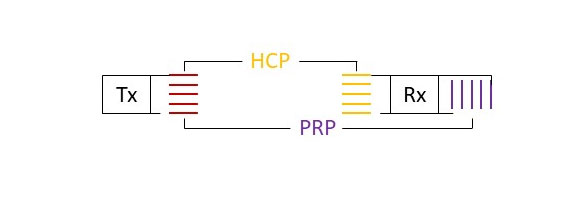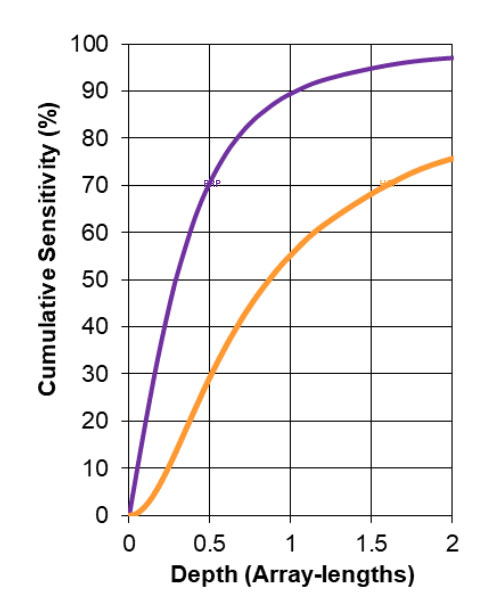DUALEM instruments measure terrain conductivity, detect shallowly buried objects of high conductivity and, in special conditions, measure the magnetic susceptibility of terrain.
DUALEM instruments can be applied to many types of shallow-earth investigations. These include soil mapping and monitoring, archaeology, the delineation of conductive contamination, resource exploration and metal detection. Electrically resistive targets at surface, such as aggregates, soil frost and tar pits, often are delineated successfully. Buried resistors such as voids and complex features such as hydrocarbon contamination, if detectable at all, require meticulous technique and expert interpretation. Highly conductive bodies are readily detected by a DUALEM if their depth of burial is shallow.
Patented DUALEM sensors incorporate an EM-transmitter that operates at a fixed frequency and 1-, 2- or 3-pairs of EM-receivers. As shown in Figure 1, the transmitter and one of the receivers in a pair have horizontal windings, and these components form the horizontal co-planar geometry (HCP). The other receiver in a pair has vertical windings; it combines with the transmitter to form the perpendicular geometry (PRP).

DUALEM sensors are designed to operate within the low-frequency-approximation of EM response, as defined by J.R. Wait in A Note on the Electromagnetic Response of a Stratified Earth: Geophysics, 27 (1962), 382-85. Low-induction-number (LIN) and resistive-limit are synonymous with low-frequency approximation. At LIN, an electromagnetic system has stable depth-sensitivity, response amplitude is linearly proportional to conductivity, and response is essentially in quadrature to the phase of the transmitted field (i.e. inphase response is negligible).
Under the assumption that DUALEM sensors will typically operate within LIN, the sensors linearly scale the quadrature component of response, in ppt of the transmitted field, into millisiemens/metre (mS/m) of apparent conductivity (ECa). (Conductivity is the inverse of resistivity, e.g. 1 mS/m conductivity equals 1000 ohm-m resistivity).
The relative sensitivity to the earth at LIN follows from a simplification of the analysis from Wait (ibid.). For PRP the sensitivity to an incremental layer in the earth is:
IPRP = 2/(4s2 + 1)3/2
where s is the depth to the layer, in units of the transmitter-receiver separation.
Integrating with respect to s gives the cumulative sensitivity of the earth to the depth s:
CPRP = 2s/(4s2 + 1)1/2
Similarly, corresponding formulae for HCP are:
IHCP = 4s/(4s2 + 1)3/2
where IHCP is the sensitivity to an incremental layer at a depth of s separations, and:
CHCP = 1 – 1/(4s2 + 1)1/2
where CHCP is the cumulative response of the earth to depth s.

The cumulative sensitivities of PRP and HCP are plotted in figure 2. Effective depth (ED) is defined as the depth to which a transmitter-receiver array accumulates half its total sensitivity, and depth of exploration (DOE) is defined as the depth to which an array accumulates 70 % of its total sensitivity.
The sensitivity of a PRP array accumulates rapidly with depth; ED is about 0.3 array lengths, and DOE is about 0.5 array lengths.
Sensitivity of an HCP array accumulates more gradually with depth; ED is about 0.9 array lengths and DOE is about 1.6 array lengths.
The arrays are sensitive to all the material beneath them, including the height of air between the array and the surface of the ground. Thus, when a DUALEM is carried at a given height above the ground-surface, the DOE in the earth for each array is reduced by this height. Note that the arrays are centered in the boom of the sensor, so the arrays are at a height of 4.5 cm where the sensor is on the ground.
Where inphase response from conductivity is negligible, DUALEM sensors can measure the inphase response due to magnetic susceptibility (as ppt of the transmitted field). Rarely, in iron-rich soils that have been exposed to fire and intense weathering, fine-grained magnetic mineralization can respond with sufficient lag, relative to the transmitted field, to alter quadrature amplitude significantly; symptoms of such response are substantial areas of negative or anomalously low HCP ECa combined with strong inphase amplitude. For such areas, interpretation of conductivity, susceptibility and susceptibility lag is suggested, supported by accurate measurements of inphase and ECa from multiple arrays.
As conductivity increases, the validity of LIN DOE and ECa deteriorate, and interpretation becomes complex. A greater proportion of response becomes inphase, so LIN ECa and DOE increasingly understate, respectively, true conductivity and the sampled volume of earth. At the LIN limit, for example, ECa understates true conductivity by about 10 %; the depth of earth providing significant ECa response decreases by a similar percentage, even as inphase response increases from a greater depth and breadth of earth. For HCP, ECa peaks where true conductivity is about 25-times the LIN limit. At this peak, ECa understates true conductivity by about 70 %, and further increase in true conductivity causes HCP ECa to decrease.
Interpretations of layered conductivity and depth can remain representative as true conductivity increases above the LIN limit, if the interpretation utilizes both inphase and ECa amplitudes. Where buried metal or other feature generates response beyond the LIN range, a DUALEM sensor continues to produce accurate and useful measurements but the interpretation of conductance, depth and geometry becomes complex.
Quadrature responds especially well to elongated conductors, such as metal pipes. Inphase becomes strong over highly conductive material, and is particularly effective for locating confined conductors, such as metal drums or boulders of graphite or sulfide. The amplitude of the response to buried metal decreases exponentially as the distance increases between the DUALEM sensor and the object. This limits the detection depth to, for example, about 2 m for a 200-L steel drum.
When using both inphase and quadrature in the analysis of EM beyond LIN, it may be convenient to convert values in mS/m back to ppt so that the units of both inphase and quadrature are the same. After Wait (ibid.), the formula for quadrature amplitude in ppt, Qppt, from ECa amplitude in mS/m for a 9-kHz DUALEM array of length m, in metres, is:
Qppt = ECa∙m2/56.3
Dualem Products
DUALEM products are used by companies and universities on every continent. Our products fulfill a variety of use-cases in industry and academia.
